Eric C. Sheninger's Blog, page 6
June 23, 2024
Ditch the Drill and Choose to Thrill: Personalization with Student Choice
There is a saying out there that I hear often: learning is learning. While I don’t discount this view, I firmly believe there is so much to it at the individual level. Preferences and experiences play a significant role in how we all learn, and interests do as well. When asked to do the same thing at the same time in the same way, it is pretty much a fact that a few people will thrive, some will get by, and others will struggle. While this notion challenges the status quo and how things have been done traditionally in education, it is the truth. The question now becomes, what are we going to do about it?
Learners have different learning needs and preferences. Herein lies the power of veering away from approaches focusing on just one way. Nicki Slaugh and I shared the following in our book Personalize:
Personalized learning compromises an array of strategies where all students get what they need when and where they need it to learn. It’s not about more work. On the contrary, it is about maximizing the time with students prioritizing their needs, resulting in better work.
Agency in the classroom is about giving students more control over their learning through greater autonomy and purpose. Many factors drive it, but the underlying premise is to move learners from a state of engagement to empowerment so that they exert more ownership over their learning. While there are many high-agency strategies to choose from when personalizing, choice stands out. It allows for the tailoring of the learning experience to student needs and strengths, leading to better retention and deeper learning through the following:
Increased Engagement: When learners have a choice in what they learn or how they learn it, they become more invested in the process. This intrinsic motivation leads to deeper engagement and a stronger desire to understand the material.Ownership and Agency: Choice fosters a sense of ownership over the learning process. Learners feel empowered to make decisions and explore topics that interest them. This sense of agency increases their responsibility for their learning and makes them more likely to take initiative.Active Exploration: Having choices encourages learners to explore different approaches, materials, or activities. This active exploration allows them to discover new information, make connections between ideas, and solidify their understanding.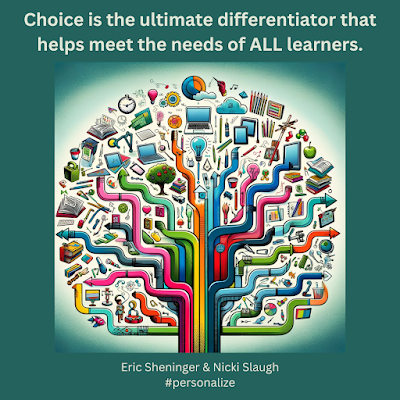
In a science class studying the human body, a teacher wants students to demonstrate their understanding of the digestive system. Traditionally, this could mean assigning a written report or a diagram labeling the organs. However, here is where incorporating student choice can personalize learning through different ways to demonstrate understanding:
Art: One student who excels in art chooses to create a comic strip explaining the journey of a hamburger through the digestive system. This allows them to showcase their artistic skills while demonstrating their understanding of the different organs involved and their functions.Technology: Another student is passionate about technology and chooses to create a stop-motion animation video depicting the digestive process. This student gets to combine their love for technology with their understanding of science.Performance: A student who thrives on public speaking chooses to write and perform a short play where the different organs of the digestive system come to life and explain their roles. This allows them to demonstrate their knowledge creatively.These are just a few examples; a teacher might provide additional options or let students develop their own ideas as long as they meet the learning objectives. The key is that students can choose a method that resonates with them and allows them to showcase their understanding effectively and enjoyably.
Recently, on my podcast, I discussed how choice can be a great differentiator that helps meet the needs of all learners. There are natural connections to differentiation. Below are the three components and some of the strategies Nicki and I go into detail about in Personalize:
Choice in content: Students can choose to learn the content with the teacher in small groups or independently through a flipped lesson or self-pacing task (reading, video, notes, slides, etc.). No matter the path chosen, checks for understanding along the way inform the student of their understanding. Choice in the process: Students can choose scaffolded and relevant tasks to complete in a must-do/may-do format, choice board, or playlist. While they work, the teacher uses data or evidence to pull individuals for intensive support.Choice in product: With a well-designed rubric, students choose how to demonstrate learning through creating a product. For examples, click HERE and HERE.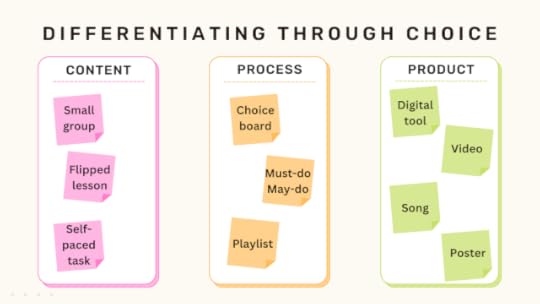
Overall, choice empowers learners, personalizes the experience, and fosters a deeper understanding of the subject matter.
Take a deep dive into personalized learning by grabbing your copy of Personalize: Meeting the Needs of All Learners on Amazon.
June 16, 2024
Student Voice as an Engagement Strategy
Imagine a classroom buzzing with curiosity, where questions fly like sparks and exploration thrives. Engaged learners are joyful learners. When students are genuinely invested, a sense of wonder takes hold. They delve into challenges with a smile, their eyes alight with the thrill of discovery. This joy of learning is contagious, fueling a classroom where knowledge isn't just absorbed; it's embraced. In this empowering environment, students blossom, reaching their full potential and embarking on a lifelong journey that sets them up for current and future success.
Engaging students today is a complex task. Educators often express the challenge of keeping students focused and interested in the learning process. This can be particularly difficult in today's world, where students are bombarded with distractions and have a multitude of competing priorities. However, research provides a beacon of hope, offering valuable insights into fostering a thriving learning environment. According to a study by Fredricks et al. (2004), students who are actively engaged in lessons demonstrate a deeper understanding of content and develop stronger critical thinking skills. By implementing effective strategies, educators can transform classrooms from places of passive absorption into dynamic hubs of active participation and intellectual growth. The following passage explores some of these strategies that can ignite a passion for learning within students.
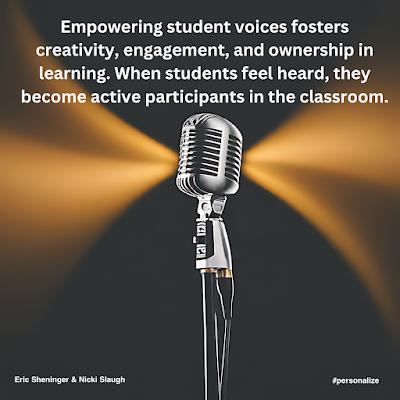
Student voice in the classroom is not just a concept; it's a catalyst for a more engaged and successful learning environment. When students feel their ideas and perspectives are heard and valued, they become more than just participants in the learning process; they become active contributors. This can lead to many benefits, including increased motivation, a deeper understanding of concepts, and a greater sense of ownership over their education. Students who believe they have a voice are more likely to be academically motivated. Teachers can tailor their lessons by listening to students to better resonate with their interests and learning styles. This two-way communication builds trust and empowers students to take an active role in their own education, preparing them to be critical thinkers and lifelong learners.
Nicki Slaugh and I shared the following in our book Personalize:
Student voice denotes any action that empowers students to express their perspectives when shaping their learning journey. The primary message here is that classroom participation is all-inclusive, promoting a greater sense of involvement for everyone.
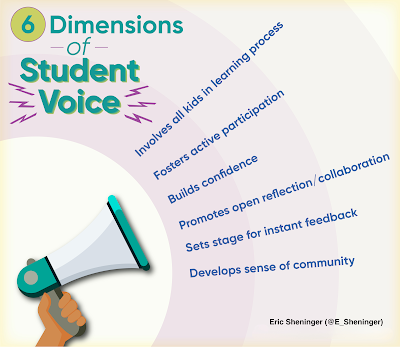
We see student voice as a gateway to personalization, especially during instruction. The image above details the many positive outcomes of this high-agency strategy. When asking questions, you can use the following to amplify the voices of your learners:
Individual whiteboardsDry-erase surfacesPost-ItsDigital toolsPhysical objects such as clothespins or signs (these can be colored red and green for students to attach to their devices or hold up during group work)Understanding that there is no right way to amplify student voice is crucial. While the list above provides a good foundation, keep in mind that you or your teachers might develop more innovative ways to let all students be heard, increasing engagement in the process while gaining valuable insight that can be used to strengthen Tier 1 instruction or improve Tier 2 supports.
Students who feel their ideas and perspectives are valued are more invested in learning. This can lead to increased motivation, a deeper understanding of concepts, and a greater sense of ownership over their education. Teachers can tailor their lessons by listening to students to better resonate with their interests and learning styles. In short, student voice is a gateway to a more successful learning experience.
Take a deep dive into personalized learning by grabbing your copy of Personalize: Meeting the Needs of All Learners on Amazon.
Fredricks, A. C., Blumenfeld, P. C., & Paris, A. H. (2004). School engagement: Importance and development. The Educational Psychologist, 39(1), 18-24.
June 9, 2024
Personalize: Meeting the Needs of ALL Learners
Fate has a funny way of bringing together people with similar views and passions. In March of 2022, I worked with a school system in Provo, Utah. During a roundtable discussion, I was asked to discuss key aspects of personalized learning that are critical to successful implementation. There were a lot of people in the room who listened to what I had to say and seemed to be hanging on every word. Little did I know that a secondary principal from a different school system was in attendance who had been blazing her own trail with personalized learning and would later share the journey of her school. Unbeknownst to me was how intrigued she was by what I shared.
After facilitating a presentation later that day, the principal introduced herself to me, and we started a lengthy conversation on aspects of personalization. Shortly after, I was contracted to work with that school in a coaching role. Over the next two years, I witnessed firsthand competency-based practices that I had never seen implemented so effectively at scale. However, the firecracker of a principal saw an opportunity for her and the school to still grow their personalized practices. That leader was Nicki Slaugh, my co-author of our book Personalize. Once I saw personalization through her lens and that of her staff, I immediately knew we needed to collaborate. The rest is now history.
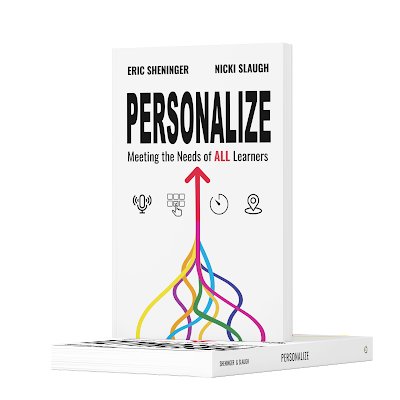
My chance encounter with Nicki eventually led to the idea of writing this book after my first year of coaching. Our goal is as simple as it is profound in that personalization is based on ALL students getting what they need when and where they need it to learn. Packed with practical examples, research-based strategies, and stories, any educator can find the most effective way to personalize learning. Here is the synopsis:
Not Just One Way
Are you an educator stuck in the traditional teaching or leadership mold, yearning for a spark to reignite your passion? Do you want to use your time better and work smarter, not harder? Personalize is your guide to transforming classrooms into dynamic hubs of exploration and discovery. This book invites you to break free from the "one-size-fits-all" approach and embrace the potential of personalized learning, where all students get what they need, when and where they need it to learn.
Imagine a classroom where all students’ unique strengths, interests, and opportunities for growth are recognized and nurtured. Where the rigid structures of traditional education give way to flexible, student-centered learning environments. "Personalize" provides the tools and strategies to create such a space, fostering creativity, critical thinking, and a genuine love for learning.
Dive into how personalized learning can revolutionize education through real-world examples, research, practical advice, and inspiring stories. You'll learn how to leverage high-agency strategies (voice, choice, path, pace, place), technology including artificial intelligence (AI), data, and innovative teaching methods to meet each student's individual needs, ensuring that no learner is left behind. The book also emphasizes the importance of building strong relationships and a positive school culture to support these changes.
Personalize is not just a book; it's a movement towards a more inclusive, engaging, and effective culture. Whether you're a teacher, administrator, coach, or librarian, this book will inspire you to make bold moves that challenge the status quo and bring out the best in your students.
Join the revolution. Embrace the journey of personalization and witness the transformative impact on your students and your educational career. Your path to rekindling the joy of being an educator starts here.
While we hope that the description above piques your attention, there are some features of the book that we would like to call out:
This book is structured so that you can either read from cover to cover or choose a particular chapter that is of specific interest or represents a needed opportunity for growth. We did this because there is no right or best way to personalize. Each chapter is supported by research, practical strategies, and anecdotal stories for essential context. At the end of each chapter is a summary section titled “Bold Moves.” These are courageous decisions that break away from traditional methods and push boundaries. They involve calculated risks and innovative solutions to address challenges and empower student growth through personalization. The questions in these sections are meant to inspire bold actions. A digital appendix fleshes out how to effectively personalize and what it could look like across various grade levels and content areas. Get ready for lots of practical examples.There is a call to action throughout the book, empowering educators to share their successes with personalized learning using the hashtag #personalize across social media networks (Twitter, Instagram, TikTok, Facebook, LinkedIn). Please tag us; we will constantly add more examples to the appendices.Working on this project with Nicki, a true practitioner who has embraced bold moves throughout her journey to personalize learning was such a joy. We hope this book will inspire, challenge, and motivate you to continue to be the best iteration of yourself of those students you serve.
You can get your copy of Personalize: Meeting the Needs of ALL Learners on Amazon. There is an impressive discount on bulk orders. If interested, email info@connecteddpublishing.com for more information.
May 26, 2024
Unpacking the Backpack
The social media landscape has changed quite dramatically when I first arrived in the space back in 2009. To put things in perspective, Instagram and TikTok were years away from existing, and Facebook was the dominant tool of choice. At that time, Twitter was emerging as the preferred space for educators to connect, and blogs were the go-to source for relevant ideas and strategies. My foray into the digital world began with the little blue bird, and I have never looked back. Being a connected educator opened my mind and eyes to what was possible and enabled me to move beyond comfort and fear to evolve into a more effective leader.
After being invited to participate in the one-and-only Google Teacher Academy for Administrators in 2010, I followed up on a goal I had set there to establish a blog. While this was one of the scariest things I ever did professionally, as I never saw myself as a writer, I decided to dive in and share my thoughts and the work in my school. Needless to say, I have been at it now for fourteen years. While I don’t blog as consistently as I once did, I still find it my preferred way to reflect and share what is working in effective teaching, learning, and leadership.
As I mentioned in the opening paragraph, change is constant, especially in digital spaces. Tools come and go, but behaviors also change. We are also seeing a shift in how people prefer to consume information, from reading to listening. From my lens, I see this as a reaction to all the demands on people’s time. Podcasts are “the” thing right now. Everyone seems to have one, and educators have several cued up and ready to go all the time. Listening to a podcast in the car or gym is much easier than reading a blog post. While I still love to write and will continue to do so, the writing was on the wall. Thus, I decided to begrudgingly enter the space with my own podcast.
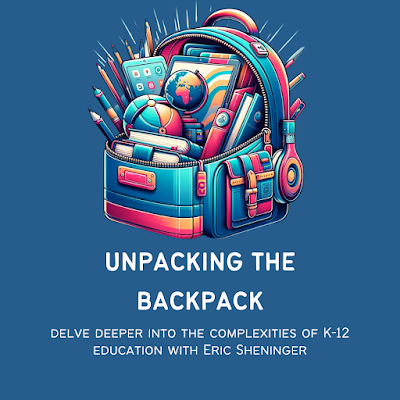
Unpacking the Backpack was born in consultation with my daughter. After coming up with a name, I used Canva to create the art. Below, you can see a description of my podcast.
Join us on Unpacking the Backpack, where we delve deep into the ever-changing world of K-12 education. In each episode, we'll unpack the complexities of teaching, learning, and leadership with a practical lens. Listen in as we:
Discuss real-world challenges Explore innovative approaches that are evidence and research-based Learn from educators and leaders on the frontlines Gain actionable insights and strategies to navigate the ever-evolving landscape
This is your one-stop shop for practical guidance and a deeper understanding of the incredible world of K-12.
Now, my podcast is going to be different from others. From a time standpoint, I couldn’t rationalize creating every episode from scratch. I also knew that I had a goldmine of content on my blog. Here is where I came up with an idea for how artificial intelligence (AI) might be able to help. This led me to search to see if there was an AI tool that could convert my blogs into podcasts. I was pleasantly surprised when I found that such a tool existed in the form of Leap AI. Talk about simple. All I needed to do was supply a link to a blog post, and in less than a minute, a professionally scripted and sounding podcast was created. It even sounds like my voice.
In addition to using Leap AI, practitioners will be invited to the podcast to discuss the most pressing issues in education and realistic solutions for implementation. I am excited about this unorthodox journey into the realm of podcasting by repurposing fourteen years of written content into audio form.
Look for it on Spotify and where all your favorite podcasts are found.
May 12, 2024
The Never-ending Upgrade: Why Constant Growth is the Key to Success
While I enjoy keynoting and facilitating workshops, it is through a coaching lens that I get to see how teachers and administrators are implementing innovative learning strategies with fidelity. Through their actions, I can collect evidence to show efficacy while curating exemplars I can share in my presentations. No matter where I go, I get the same message from educators on their desire for practical strategies. There is no better example than those implemented in classrooms, schools, and districts.
“Eric, we know the why. To move our practice, we want to see how it can be done and what it could look like.”
The quote above is something I hear over and over again as I support school systems across the world. This quote is important to educators because it highlights the importance of moving from theory to practice. While understanding the reasons for change (the why) is important, it is equally important to see how this change can be implemented (how) and what the results might look like (what it could look like), something I elaborate on in Disruptive Thinking in Our Classrooms. Here’s why:
Educators need practical guidance: Ideas and strategies are often handed down from above, with little guidance on how to implement them in the classroom. Educators need to be shown how to put these into practice.Sharing effective practices: By sharing examples of what has been implemented successfully, educators can learn from each other and improve their own practice.Building a vision for change: Seeing what innovation could look like can help educators stay motivated and committed to making changes.
Thus, when I am in certain places, I always check in on educators who push the envelope and crave feedback so they can grow. A few weeks back, I was in Stryker Local Schools (OH), where I have been supporting the district this past year. One classroom I always try to visit is that of Larry Freshour, an elementary technology teacher. For starters, he is always craving feedback. I can’t remember a time this past school year when we had a conversation, and he didn’t mention how he was implementing an idea or strategy that he learned during one of the professional development days I facilitated. The other reason is that he thoroughly engages learners using a rotational model, immersing students in thought-provoking tasks.
During a recent visit, he had just finished up with a hook on circuits using a short video from Flocabulary. When I entered, the class was already completing lightsaber cards in honor of May the 4th, which Star Wars fans are undoubtedly aware of and have this date marked on their calendars. Research has shown how vital relevance is to learning and Larry makes great efforts to impart authentic contexts and application during each lesson. Students were seen throughout the room creating working circuits to ignite the lightsaber. Self-regulation, pacing, and intrinsic motivation were on full display.
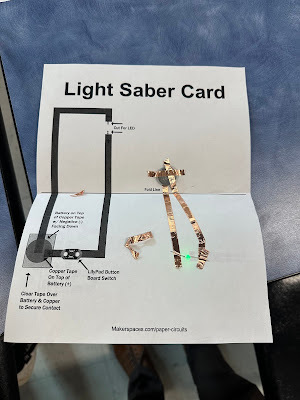
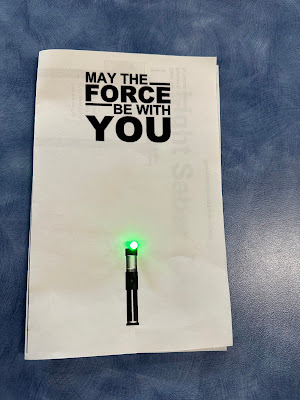
Constant growth is the key to success because our world is always changing. By continuously learning new skills, adapting to new situations, and pushing ourselves beyond our comfort zones, we stay relevant, overcome challenges, and unlock our full potential as educators. This growth mindset fuels progress, keeps us engaged, and allows us to reach new heights consistently, just like Larry.
May 5, 2024
Quantifying Innovative Practices
Lately, I've been giving a lot of thought to effectiveness, and this has been mirrored in my writing and work as a coach. Reflecting on my time as a principal at my previous school, I recall the successful shift towards digitalization and incorporating innovative practices. Our main goal was to demonstrate tangible improvements rather than just discuss them. We merged quantitative and qualitative measures to validate each innovative idea's reasons, processes, and outcomes in detail. The critical element in this equation was skillfully purposefully employing digital resources while ensuring consistency and continuity in all our old and new practices.
As a principal, I persistently sought methodologies and procedures to gauge the effects of the changes we were enacting. Regrettably, no such solutions were available. As I engage with districts and schools regularly, they frequently inquire about ways to gauge the outcomes and efficacy of their innovative strategies, such as BYOD, 1:1, blended and personalized learning, classroom and school redesign, branding, makerspaces, and professional development. This got me thinking about what might be missing to ensure efficacy.
As the CEO of Aspire Change EDU, I'm dedicated to research-driven, data-enhanced, and evidence-based services and resources to aid districts, schools, and organizations in transforming teaching, learning, and leadership. Among these resources stands the Innovative Practices Assessment (IPA), which was created to fill a void in moving from ideas and innovative practices to results that improve the learning culture.
The IPA establishes the framework for educators and administrators, facilitating an innovative lens to underpin individualized professional growth. It initiates by scrutinizing the tactics instituted within each educational institution, at the school or district level, which bolster student learning through technological integration, encompassing dimensions like rigor, pertinence, interpersonal bonds, involvement, and the broader ethos. Subsequently, the procedure advances to comprehending the extant leadership methodologies that effectively usher in technology and groundbreaking approaches. These methods are harmonized with the 7 Pillars of Digital Leadership & Learning. (Student Learning, Learning Spaces and Environment, Professional Growth, Communication, Public Relations, Branding, and Opportunity).
Through this proven model, schools and districts can identify opportunities to begin their transformation or take their digital and innovation goals to the next level. The IPA combines a self-reflection questionnaire rubric, on-site observations, and extensive data and evidence collection inventories. Rubrics are then leveraged to observe leadership and instructional practices while collecting artifacts to provide evidence of efficacy-based innovative practices. Once collected and analyzed, a detailed summary report outlining areas of success, focus opportunities, and recommended next steps will guide the professional learning journey, supporting the development of a strategic implementation plan.

Here is a summary of the IPA process:
Step 1: The IPA questionnaire is completed by the district or school. This 18-question rubric asks school leaders to reflect on their perceptions of where their school falls, from needing to start to well-developed. School leadership teams are expected to collect and document aligned evidence for each item during this reflective process. This information will then be reviewed at the initial meeting for reflection and goal-setting to grow and improve. The baseline evidence shared is in the context of determining the fidelity of innovative practices that currently exist and are implemented on a routine basis (including examples of data, lesson plans, unit plans, student work, PLC minutes, rigorous digital performance tasks, walk-through forms, assessments, sample observations/evaluations, portfolios, PD plans, social media accounts, pictures, videos, press releases, media coverage, partnerships, etc.).
Step 2: On-site observations and interviews with leaders, staff, and students are conducted to validate perceptions and evidence collected for the questionnaire. Targeted classroom observations of student learning aligned with the mission and vision of the school(s) are also conducted. Additional data is collected for analysis in the final report. The idea is to engage school leaders in dialogue about their culture, student learning, and practices, regardless of their transformation.
Step 3: The data and evidence are tightly aligned to research-based rubrics to provide a detailed view of where a district or school is with its transformation. The data and artifacts are analyzed, leading to a summary report detailing the current state of practice at each school or district.
Step 4: The IPA report is shared and discussed with the school or district leadership team. Observations about the evidence collected are shared and discussed. During the strategic planning process, discussions focus on areas of strength and improvements to develop a tailored and personalized implementation plan.
Step 5: On-going professional learning is implemented and progress monitoring through the robust questionnaire is documented to determine the efficacy of the transformation efforts using innovative approaches.
The IPA process has been created to support districts and schools looking for ways to measure and articulate the impact of technology and innovation on practice. While data is valuable, it moves beyond this as the only metric for success by actually taking a lens to an array of strategies and practices that combine to create a thriving learning culture.
The IPA doesn’t just look at innovation. It also provides insight into all elements of school culture and student learning. In addition to being informed by a broad body of research and driven by evidence, the IPA process is also aligned with the following:
Future Ready Schools (Click HERE to view a detailed alignment document) National Education Technology Plan (NETP)Books that showcase evidence and changes to practice aligned with researchDisruptive Thinking in Our Classrooms: Preparing Learners for Their FutureDigital Leadership: Changing Paradigms for Changing TimesUncommon Learning: Creating Schools That Work for KidsBrandED: Tell Your Story, Build Relationships, and Empower LearningLearning Transformed: 8 Keys to Designing Tomorrow’s Schools, TodayEvaluation of our practice is essential to grasp our current position and the impact of alterations. We aspire that the IPA process will aid you in shaping, honing, gauging, and subsequently disseminating remarkable innovative practices that vividly portray the achievement of effectiveness.
Reach out today to have a conversation on how the IPA process can help transform your school, district, organization, or system (AspireChangeEDU@gmail.com)
April 21, 2024
The Fallacy of Best Practices
In an education world obsessed with standardization, the pursuit of "best practices" reigns supreme. Countless systems and schools rely on pre-defined, one-size-fits-all approaches, promising guaranteed success. However, this rigid adherence to a single ideal can stifle innovation and hinder progress. We must shift our focus to effectiveness – achieving desired results in a way that adapts to unique situations.
The allure of best practices lies in their simplicity. They offer a seemingly foolproof formula, eliminating the need for critical thinking and tailored solutions. This, however, ignores the dynamic nature of learning. Industries evolve, technologies change, and societal needs are constantly in flux—context matters. A practice deemed "best" today might be obsolete tomorrow, especially in a disruptive world. Chasing an elusive ideal can leave schools stagnant, resulting in students who cannot adapt to new circumstances. The reality is that there is no such thing as a “best” practice. If there were, every system, district, school, and educator would implement them with high fidelity and get amazing results.
Effectiveness, on the other hand, prioritizes results. It encourages experimentation, research-based pedagogy, and data-enhanced decision-making. Schools that embrace effectiveness analyze their specific context, identify goals, and then explore diverse approaches to achieve them. This fosters a culture of innovation, where solutions are not copy-pasted but thoughtfully crafted.
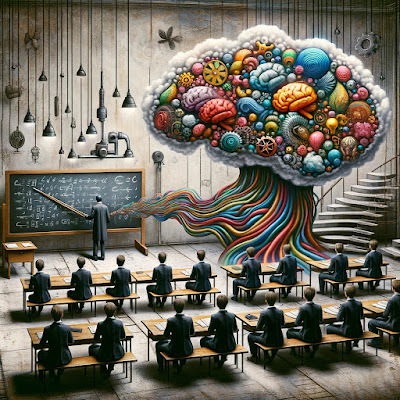
Imagine a marketing campaign: a "best practice" approach might dictate a specific social media strategy. However, focusing on effectiveness would analyze the intended audience and platform trends, potentially leading to a more innovative, targeted approach. Like a marketer analyzing their audience and platform trends to tailor their approach, educators should assess their students' individual and collective needs, key concepts, and the most recent pedagogical research. This could lead to more innovative, personalized, and effective teaching strategies that deviate from traditional practices but result in better learning outcomes.
Best practices often lack nuance. They are developed based on broad trends in education or a world that no longer exists, failing to account for unique strengths and weaknesses at the school or individual level. Effectiveness, however, thrives on understanding specificities. It empowers schools to leverage their unique assets – their culture, staff skillset, or niche expertise – to achieve their goals in a way that optimizes their strengths. This approach encourages autonomy, knowing what actually works in a given context, and innovation, allowing for the adoption of cutting-edge strategies that resonate with the current generation of students. It also fosters a more dynamic environment where feedback and data from actual classroom experiences can shape ongoing approaches, keeping learning relevant and impactful.
The shift towards effectiveness is a testament to the power of educators and schools. It requires a change in mindset, a move away from blind adherence to methodologies that some figureheads and organizations claim are the only way to get results, and instead, a move towards continuous learning and adaptation. Schools need to invest in ongoing support, evidence collection, and analysis, allowing them to track the success of their chosen strategies. They must cultivate a culture of open communication where educators feel empowered to challenge assumptions and propose alternative methods.
Embracing effectiveness isn't about discarding all existing knowledge. Established practices can serve as valuable starting points. The key lies in using them as a springboard, not a rigid blueprint. Schools gain the agility and creativity needed to navigate an ever-changing world by prioritizing effectiveness, not clinging to the fallacy of best practices. Achieving real results in a dynamic world trumps a theoretical ideal.
The time has come to break free from the shackles of "best practices" and embrace the power of effectiveness driven by the true experts in education—the schools and educators who implemented these strategies consistently and with a high degree of fidelity. It is these people who move an idea into action and determine its effectiveness.
April 7, 2024
11 Artificial Intelligence (AI) Tools to Support Effective Teaching and Leadership
It goes without saying that AI is a hot topic of conversation in education circles and beyond. In the beginning, I was a skeptic myself, but now I use it to support my professional work, especially when I coach leaders. While there are legitimate concerns and anything generated by AI needs to be fully vetted, the most profound benefit is how it can save educators precious time. Teachers can use it to help design lessons, build assessments, unpack standards, personalize, scaffold questions, develop hooks, provide relevant connections, and so many more possibilities. Leaders can use certain AI tools to streamline communication, personalize feedback, provide targeted support to staff, find peer-reviewed research in a snap, and aid in other leadership tasks.
Here are some of the most popular tools being used at this moment:
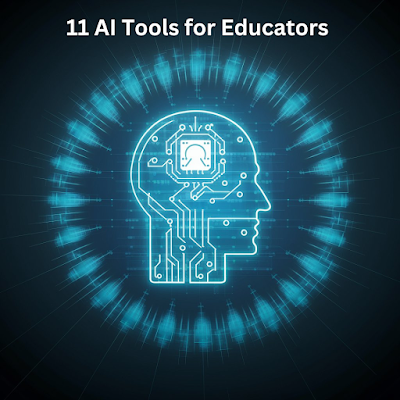 Magic School - Get help with lesson planning, differentiation, writing assessments, and so much more. Click on the “magic tools” tab at the top of the page to see all of the options available to teachers. School AI - Know what students need, when they need it and deliver it with AI support. The company behind this tool is extremely committed to data privacy. QuestionWell - Generate an endless supply of questions so you can work smarter, not harder.Gradescope -Seamlessly administer and grade all of your assessments, whether online or in class. Save time grading and get a clear picture of how your students are doing.Parlay - Facilitate meaningful, measurable, and inclusive class discussions.Diffit - This is a great tool for differentiation. It allows teachers to get “just right” instructional materials, saving tons of time and helping all students access grade-level content. Chat GBT – A chatbot that uses natural language processing to create humanlike conversational dialogue. It can respond to any prompt, such as unpacking a standard into scaffolded questions or differentiating aligned tasks. I recently used it when working with a fourth-grade teacher to create a song on long division as part of a review activity. Users who have the paid version can create elaborate images. Gemini – A chatbot from Google that is very similar to Chat GBT. The free version allows for the creation of pictures that do not contain people. Brisk Teaching – A Google Chrome extension that helps busy teachers save time in the tools they already use, like Google Classroom, Docs, Slides, YouTube, and online articles. In seconds, teachers can create unlimited instructional materials, give feedback, evaluate student writing, and level or translate texts - all without needing to switch between apps. Ideogram – A free image creation tool. Create picture prompts for worksheets and writing tasks. During coaching sessions, I have helped elementary teachers create images for sight words.Copilot (free, but need a Microsoft login) – Very similar to Chat GBT and Gemini.
Magic School - Get help with lesson planning, differentiation, writing assessments, and so much more. Click on the “magic tools” tab at the top of the page to see all of the options available to teachers. School AI - Know what students need, when they need it and deliver it with AI support. The company behind this tool is extremely committed to data privacy. QuestionWell - Generate an endless supply of questions so you can work smarter, not harder.Gradescope -Seamlessly administer and grade all of your assessments, whether online or in class. Save time grading and get a clear picture of how your students are doing.Parlay - Facilitate meaningful, measurable, and inclusive class discussions.Diffit - This is a great tool for differentiation. It allows teachers to get “just right” instructional materials, saving tons of time and helping all students access grade-level content. Chat GBT – A chatbot that uses natural language processing to create humanlike conversational dialogue. It can respond to any prompt, such as unpacking a standard into scaffolded questions or differentiating aligned tasks. I recently used it when working with a fourth-grade teacher to create a song on long division as part of a review activity. Users who have the paid version can create elaborate images. Gemini – A chatbot from Google that is very similar to Chat GBT. The free version allows for the creation of pictures that do not contain people. Brisk Teaching – A Google Chrome extension that helps busy teachers save time in the tools they already use, like Google Classroom, Docs, Slides, YouTube, and online articles. In seconds, teachers can create unlimited instructional materials, give feedback, evaluate student writing, and level or translate texts - all without needing to switch between apps. Ideogram – A free image creation tool. Create picture prompts for worksheets and writing tasks. During coaching sessions, I have helped elementary teachers create images for sight words.Copilot (free, but need a Microsoft login) – Very similar to Chat GBT and Gemini. Another tool that I have begun to explore is Leap. It can convert my blog posts to podcasts that sound very professional. When I listened to the first recording, I was amazed. Stay tuned as I launch my podcast later this year.
AI can be an invaluable timesaver for all educators. However, it is important to note that it cannot facilitate lessons and feedback conversations. It is a tool to support effective practices, not drive or replace the work of educators. The real power behind AI is the people who use it strategically to work smarter, not harder.
March 24, 2024
AI in the Classroom: A Teacher's Toolkit for Transformation
The landscape of education is constantly evolving, and artificial intelligence (AI) is emerging as a powerful tool for educators. While it won't replace the irreplaceable human touch in the classroom, AI can significantly enhance teaching and learning by offering personalization, efficiency, and insightful data analysis. Below are some ways educators can leverage AI to create a more dynamic and effective learning environment while also getting professional learning support from Five Star Technology Solutions.
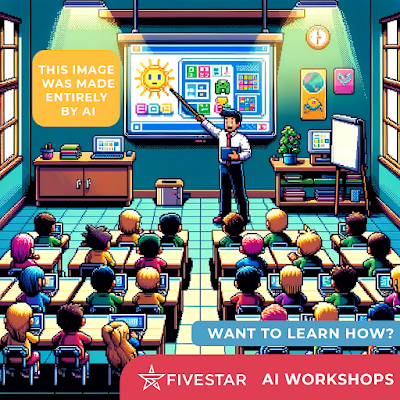
Personalized Learning Pathways
Imagine a classroom where each student receives instruction tailored to their specific needs. AI-powered platforms can analyze student data, including test scores, past performance, and learning styles. This allows educators to curate individualized learning pathways, suggest resources, adapt difficulty levels, and provide targeted feedback. Students who grasp a concept quickly can move on to more challenging material, while those needing extra support can receive targeted practice and additional explanations. To learn more, take a look at this blog post I wrote on the topic.
Grading and Feedback Systems
AI-driven grading systems can automate the process of assessing short answer questions, multiple-choice tests, and written assignments, freeing up valuable teacher time for more in-depth feedback and one-on-one interaction with students.
Data-Enhanced Instruction
AI can help educators analyze vast amounts of data related to student performance, class trends, and curriculum effectiveness. Educators can make data-enhanced decisions about instructional strategies, pedagogical approaches, resource allocation, and intervention plans by identifying patterns and pinpointing areas of difficulty. This allows for a more proactive approach to addressing student needs and ensuring all learners are on track for success.
Accessibility and Inclusivity
AI tools like text-to-speech and speech-to-text can create a more inclusive learning environment for students with disabilities. AI-powered captioning can make direct instruction and video content accessible to students who are deaf or hard of hearing, while language translation tools can support English language learners.
Engaging and Interactive Learning Experiences
AI can be used to create interactive learning activities and simulations that make the learning process more engaging and enjoyable for students. Gamification elements can motivate students and foster a sense of healthy competition. Additionally, AI-powered simulations can provide students with real-world experiences and allow them to practice critical thinking and problem-solving skills in a safe environment.
Professional learning support can help teachers maximize AI in the classroom and beyond. Five Star is offering some fabulous workshops on the topic. You can learn more about their programs HERE.
While AI offers numerous benefits, it's crucial to remember that it is a tool to empower educators, not replace them. The human connection between teacher and student remains central to fostering creativity, critical thinking, and social-emotional development. The role of teachers will shift towards becoming facilitators, curators, and mentors who guide students through personalized learning journeys. By harnessing the power of AI, educators can create dynamic and effective classrooms that cater to each student's individual needs. This paves the way for a more engaging and enriching learning experience that empowers students to thrive.
March 17, 2024
Cultivating Lifelong Learners: How to Support Personalized Teacher Growth
Imagine a classroom buzzing with engaged students, actively constructing knowledge and diving deep into topics that spark their curiosity. This vibrant learning environment does not just happen by chance. It thrives under the guidance of a passionate, skilled educator who is constantly evolving alongside their students. However, like their students, teachers need personalized growth opportunities to stay engaged, motivated, and effective.
Teachers are the backbone of any thriving learning environment. Nevertheless, just like their students, educators thrive in personalized learning experiences. In a world of standardized tests and rigid curricula, fostering a culture of continuous, personalized growth for teachers allows them to stay abreast of current trends and effective strategies, maximize time, and become the best iteration of themselves for the learners they serve.
Here is how educational leaders can champion personalized professional learning for their teachers:

Needs Assessment: Start with the Individual
One-size-fits-all professional development (PD) is a recipe for disengagement. PD is typically done to teachers something other than what they actively want to be a part of or crave. A shift to personalized professional learning can change this dynamic. Effective leaders begin by understanding each teacher's unique needs and aspirations. Conduct individual needs assessments through surveys, goal-setting conversations, or classroom observations. This allows you to tailor professional learning opportunities that address specific skill gaps, teaching styles, and career goals (Guskey, 2000).
Embrace Choice and Variety
Move away from the traditional "sit-and-get" PD model. Offer teachers a diverse menu of learning opportunities. This could include workshops on specific instructional strategies, online courses on emerging educational technologies, or peer coaching programs that foster collaboration. Allow teachers to choose formats and topics that resonate with their individual learning preferences and goals (Desimone, 2009).
Leverage Technology for Flexibility
Technology can be a powerful tool for personalized learning. Online courses and learning modules allow educators to access content at their own pace and on their own schedules. Additionally, micro-learning opportunities through bite-sized videos, podcasts, or webinars that cater to busy schedules and allow for focused learning on specific topics should be considered (Moeller & Allen, 2017).
Empower Teacher Leadership
Teachers are a wealth of knowledge and experience. Empower them by creating opportunities for leadership within the professional development framework. Encourage them to lead workshops, share best practices with colleagues, or mentor other teachers in specific areas of expertise. This fosters a culture of collaboration, validates teachers' expertise, and fuels their intrinsic motivation to learn and grow.
Celebrate Growth and Achievement
Recognition is a powerful motivator. Regularly acknowledge and celebrate teachers' professional growth milestones. Highlight innovative practices implemented in the classroom or successful application of newly acquired skills. This public recognition reinforces the importance of continuous learning and inspires others to embark on their own personalized growth journeys.
Prioritize Reflection and Feedback
Growth does not happen in a vacuum. Create a safe space for teachers to reflect on their learning experiences. Host post-workshop discussions, provide feedback mechanisms, or encourage using professional learning communities (PLCs) where teachers can share successes, challenges, and best practices.
Invest in Teacher Wellbeing
Teacher stress and burnout are real challenges. Supporting personalized growth extends beyond professional development. Promote a healthy work-life balance by offering flexible schedules, stress management workshops, or on-site wellness programs. A well-rested and supported teacher is more receptive to learning and innovation.
By embracing these strategies, educational leaders can move away from a one-size-fits-all approach and create a continuous, personalized growth culture for their teachers. This fosters a more engaged, motivated, and ultimately, more effective teaching staff – a win-win for educators, students, and the entire learning community. Always keep in mind that the key to success with any form of professional learning is that it is part of a job-embedded and ongoing model.

Efficacy should be the goal of all professional learning. Learn more about how Aspire Change EDU helps districts, schools, and organizations personalize professional learning HERE.
Desimone, L. C. (2009). Improving teacher quality in an era of educational reform. Educational Researcher, 38(8), 649-664.
Guskey, T. R. (2000). Evaluating professional development. Thousand Oaks, CA: Corwin Press.
Moeller, S. C., & Allen, J. (2017). Microlearning for professional development: A systematic review. TechTrends, 61(3), 286-293.



